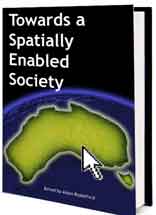Towards a Spatially Enabled Society

Edited by: Associate Professor Abbas Rajabifard (2007)
Table of contents
Foreword, Stig Enemark
Foreword, Peter Holland
Foreword, Ian Bishop
Preface, Abbas Rajabifard
| Chapter | Title | Authors |
|---|---|---|
| Part 1: The Next Generation of Land Administration Systems to Support Sustainable Development | ||
| Chapter 1 | Land Administration: the Next Generation | Peter Dale |
| Chapter 2 | The Global Agenda: Towards Pro Poor Land Tenure Systems and Integrated Land-Use Management for Sustainable Development | Stig Enemark |
| Chapter 3 | Good Governance: What Does It Mean for Surveyor’s Profession and Contributions? | Holger Magel and Silke Franke |
| Chapter 4 | E-Government and e-Land administration in Order to Spatially Enable a Society | Paul Van Der Molen |
| Chapter 5 | Institutional Renewal: Challenges and Opportunities | Don Grant |
| Chapter 6 | Natural Resources Information: A Vital Component of the Next Generation of LAS to Support Sustainable Development | Brian G. Lees |
| Chapter 7 | The Next Generation of LAS to Support Sustainable Development, Filling the ‘Holes in the Maps’ | Tony Burns |
| Chapter 8 | Reducing Urban Poverty through Pro Poor Approaches on Land Governance, Spatial Units and Land Registration | Clarissa Augustinus and Ulrik Westman |
| Chapter 9 | Spatially Enabling Mortgage Markets in Australia | Jude Wallace |
| Chapter 10 | Adverse Possession as Repair Mechanism: Recent Developments and Further Reflections | Malcolm McKenzie Park |
| Chapter 11 | Land Administration and Sustainable Development: Informed for Engagement | Lisa Ting-Chan |
| Chapter 12 | An Evaluation Framework for Land Administration Systems | Daniel Stuedler |
| Chapter 13 | Next Generation of Land Administration Systems to Support Sustainable Development | Kate Dalrymple |
| Chapter 14 | Brave New World: Innovative Tools for Spatially Enabling Land Administration | Rohan Bennett |
| Chapter 15 | Spatially Enabling Societies by Shifting the Basic Building Block | Mohsen Kalantari |
| Part 2: SDI development to support a spatially enabled society | ||
| Chapter 16 | Monitoring SDI Developments to Support a Spatially Enabled Society | Ian Masser |
| Chapter 17 | SDI Design to Facilitate Spatially Enabled Society | Abbas Rajabifard |
| Chapter 18 | SDI and the Revolution in Land Administration Policy | Jim Riddell |
| Chapter 19 | Shared Land Information Platform – Spatially Enabling Western Australian Business and Citizen | D. Britton, M. Bradford and G. Searle |
| Chapter 20 | Cultural Diversity and the GSDI Vision | Santiago Borrero |
| Chapter 21 | SDI and Privacy: Conflicting Interests of the Spatially Enabled Society | Bastiaan van Loenen and Jitske de Jong |
| Chapter 22 | SDI Management: a Framework to Guide Business Design | T O Chan |
| Chapter 23 | Geographically Referenced Statistics within a SDI | Serryn Eagleson |
| Chapter 24 | SDI Development to Support a Spatially Enabled Society | Jessica Davies |
| Chapter 25 | Measuring and Modelling the Performance of SDI at the Sub-National Level: Some Research Challenges | Kevin McDougall |
| Chapter 26 | Re-engineering SDI Development to Support a Spatially Enabled Society | Andrew Binns |
| Chapter 27 | Spatial Data Integration: a Necessity for Spatially Enabling Government | Hossein Mohammadi |
| Chapter 28 | Seamless SDI Model to Facilitate a Spatially Enabled Society | Sheelan Vaez |
| Chapter 29 | The Role of Urban Planning and Local SDI Development in a Spatially Enabled Governmen | Faisal Qureishi |
| Chapter 30 | Spatial Enablement Current Activities and Future Directions | Abbas Rajabifard, Jude Wallace and Andrew Binns |
| Part 3: Career of Prof Ian Williamson | ||
| Historical Moments in Geomatics | Arnold Bregtand Joep Crompvoets | |
| Message from John McLaughlin | ||
| Research Contribution of Professor Ian Williamson | ||